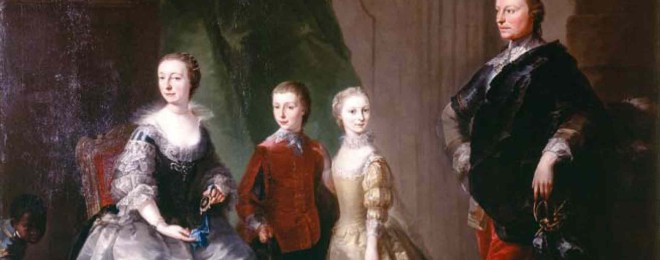
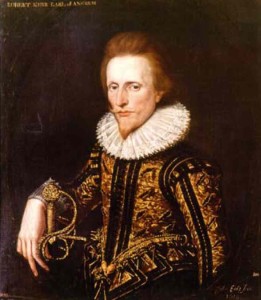
Robert, 1st Earl of Ancram
Robert, 1st Earl of Ancram, descendant in the male line of the Kerrs of Ferniehurst, was a strong supporter of the Stuarts. He followed King James VI to London and was present at his coronation in 1603. A highly educated man, a poet and philosopher, he was appointed tutor to Henry, Prince of Wales and then to Prince Charles. He was also made Captain of the King’s Bodyguard in Scotland. Born in 1578, Robert was the son of William Kerr and Margaret Home. In 1625 he sat in Parliament as MP for Aylesbury and was knighted; in 1628/9 he was MP for Preston.
Charles I had great esteem for his old tutor and created him Gentleman of the Bedchamber; at Charles I’s coronation he was Keeper of the Privy Purse and in 1633 was created Earl of Ancram in the peerage of Scotland. Robert Ancram remained staunchly loyal to the King in the Civil War and died in penury in exile in Amsterdam in December 1654. Cromwell paid his funeral expenses.
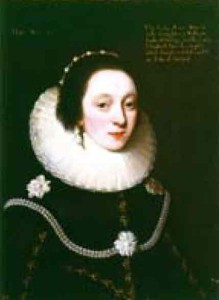
Lady Anne Stanley
On his death the Ancram title was inherited by Charles, his son by his second wife, Lady Anne Stanley, who died in 1690. The eldest son by the first marriage, William, became (by right of his wife Anne), the 3rd Earl of Lothian. He was a strong Covenanter and opposed to Charles I, in contrast to his father’s steadfast loyalty to the Throne. Clarendon said that he was ‘amongst those who on all occasions carried the rebellion highest and showed the most implacable malice to the person of the King.’
William had been educated at Cambridge and served in the Army of the States General of Holland. In 1638 he joined the Scottish rebellion against Charles I. He was Governor of Newcastle for the Scots in 1640/1 and Lieutenant-General of the Scottish Forces in Ireland in 1645. At Newcastle, on 5 May 1646, he had the satisfaction of accepting the King’s surrender and taking him into custody. Though he opposed the execution of Charles I, he served as Secretary of State in Cromwell’s government from 1649 – 1652. He later switched his allegiance to Charles II, a change of mind which probably saved his life and he was merely fined £6,000 at the Restoration!
His eldest son, Robert, also succeeded his uncle as 3rd Earl of Ancram, as well as his father as 4th Earl of Lothian. He was born in 1636 and educated in Scotland, the University of Leyden and the military academy at Saumur. From 1651-57 he embarked on a Grand Tour of the Continent with his younger brother William in the charge of a tutor, Dr. Maurice Young. As part of this extended education he learnt to ride horses according to the Haute Ecole method at Angers.
As a man with an exceptionally fine education he was predestined for high public service. Among other posts he was appointed a commissioner for the Exchequer and the Treasury. A strong supporter of William III, he was later a keen proponent of the Act of Union between England and Scotland, for which he also acted as a commissioner. He was created Marquis of Lothian in 1701 and died in 1703.
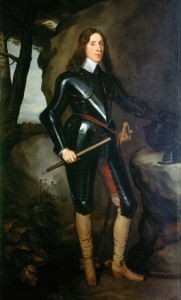
William 3rd Earl of Lothian
He was succeeded as 2nd Marquis by his son William, a Major General in the army (Scots Guards), who was also a strong supporter of William III and the Union. He was created a Knight of the Thistle and elected a representative peer for Scotland, but was considered by some to be irreligious and loose in his morals. He was described when a young man as ‘active in the Revolution against King James; he hath abundance of fire and may prove a man of business when he applies himself that way… He is brave in his person, loves his country and his bottle; a thorough libertine; very handsome.’
The 3rd Marquis of Lothian succeeded in 1722 and like his father before him was a Knight of the Thistle and a representative peer for Scotland. He served as Lord High Commissioner of the General Assembly of the Church of Scotland on three occasions, and was Lord Clerk Register of Scotland. His son William Kerr, 4th Marquis, followed a military career, eventually becoming a general. He commanded the mounted regiment known as ‘Kerr’s Horse’, later the 11th Dragoons; he was also ADC to the British commander, The Duke of Cumberland at the Battle of Fontenoy in 1745, where he was wounded. In 1746 at Culloden, where his younger brother Robert was killed, he commanded the left wing of the cavalry in the Royal army. He married an heiress, Caroline Darcy daughter of Robert Earl of Holderness, who brought him a fortune of £20,000. She was the descendant of the Duke of Schomberg, William III’s general at the Battle of the Boyne, a descent which is commemorated by the frequent use of Schomberg as a first name by subsequent generations of the Lothian family. The Duke’s wife was the great-great-granddaughter of Mary, Queen of Scots.
The 5th Marquis, William John, was born in 1739 and educated at Eton. Like his father he was colonel of the 11th Dragoons and also became a general, and in 1778 Gold Stick to George III. He was considered to be a bad manager of the estates by his family and in the end he retired to Farnham in Surrey where he died in 1815. He was described by Henry Fox, Lord Holland, as ‘a vain insignificant puppy, lively but ugly.’ This is borne out in his portraits.
His son William, the 6th Marquis, was more business-like than his father and put the family finances on a sounder base, beginning the series of Nineteenth Century improvements on the Monteviot estate. His greatest achievement was the construction of the Wellington Monument on Penielheugh, and the surrounding plantations of trees. He was also active in public life, becoming Lord Lieutenant of Roxburgh and Midlothian, and Grand Master of the Scottish Freemasons. In 1821 he was given a United Kingdom barony in the Coronation Honours of George IV, which thereafter entitled the family to an automatic seat in the Upper House, rather than being elected a representative Scottish peer (under the terms of the Act of Union). Lady Susan Napier (daughter of the Duke of Richmond) described the 6th Marquis as…
‘like his grandmother, but not so sensible, though equally red-faced, good-humoured, gentlemanlike and well made.’
His first marriage to Henrietta Hobart, daughter of the 2nd Earl of Buckinghamshire and divorced wife of Lord Belmore, caused something of a scandal but led eventually to the inheritance by the Lothians of Blickling in Norfolk, the Hobart estate.
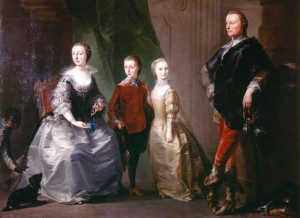
4th Marquis and family
The 7th Marquis abandoned the Whig tradition of the family by becoming a Tory and serving as an MP in Lord Liverpool’s government, before inheriting the titles. Like his father he was Lord Lieutenant of Roxburghshire, and continued the improvement of the Monteviot estate, commissioning a design for a large new mansion there from the English architect Edward Blore, though only a small part of it was executed. In 1831 he married Lady Cecil Talbot, daughter of the 2nd Earl Talbot (whose brother succeeded as 17th Earl of Shrewsbury). In 1850 she converted to Catholicism – joining a band of pious aristocrats known as the ‘Farm Street Ladies’, and died in Rome in 1877. They had four sons, from whom all the subsequent Marquises are descended.
The 7th Marquis suffered from ill health and died young in 1841, being succeeded as the 8th Marquis by his nine year old son William Schomberg, known as Billy to his family. Educated at Eton and Christ Church, the 8th Marquis was a distinguished scholar who gained a Double First at Oxford. He was a collector of books and pictures, a member of the Roxburghe Club, and a patron of avant garde contemporary artists like Hungerford Pollen and G. F. Watts. He himself wrote two books, including the History, Literature, and Art of Italy in the Middle Ages. A brilliant career was, however, cut short by illness and like his father before him, he died young.
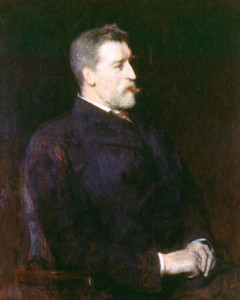
Schomberg, the 9th Marquis
The 8th Marquis married Lady Constance Talbot but they had no children and he was succeeded by his brother Schomberg as the 9th Marquis. He was among the most distinguished members of the family. Educated at Glenalmond, Eton and Christ Church, Oxford, he also gained a Double First, and then embarked on a military and diplomatic career. Between 1858 and 1865 he served as attaché in Frankfurt and Tehran (seeing active military service in Persia) and travelled widely making sketches of buildings and landscapes as he went. After inheriting, he served in Lord Salisbury’s Conservative government as Keeper of the Privy Seal and Secretary of State for Scotland from 1887–1892. He was also Captain General of the Royal Company of Archers and President of the Scottish Society of Antiquaries, the Scottish Text Society and the Highland Agricultural Society, which gives an indication of his range of interests. He married Lady Victoria Scott, eldest daughter of the 5th Duke of Buccleuch.
He made Monteviot the main family house, in preference to Newbattle Abbey in Midlothian, hitherto the principal family seat, and carried out many improvements; he built a chapel, extended the stables, a model dairy farm at Harestanes and added the water tower in the East wing to pump up the chapel organ. He was also a keen gardener and forester. Life at Monteviot in his time is captured in the diary kept by his younger daughter Cecil, with her descriptions of the estate Christmas parties and servants’ dances; of house parties for cricket in the summer on the cricket ground (which remained in use until 1939) and shooting in the winter, as well as boating and canoeing on the river, fishing for trout, hunting with the Buccleuch hounds, tennis, and racquets in the new ‘Fives Court’ next to the chapel. This idyll was shattered by the death of the eldest son, William, in 1895 in a shooting accident in Australia where he was ADC to the Governor of New South Wales.
The title was therefore inherited by the youngest son, Robert, who succeeded his father in 1900. The 10th Marquis was educated at Eton and Christ Church, Oxford, but took no part in public life and suffered from ill health; he lived quietly at Monteviot till his death in 1930.
He was succeeded as 11th Marquis by a cousin, Philip, son of Lord Ralph Kerr (third son of the 7th Marquis) and Lady Anne Fitzalan Howard, daughter of the 14th Duke of Norfolk. Philip had an active career in Lord Milner’s ‘Kindergarten’ in South Africa. He was a Liberal and as secretary to the Prime Minister Lloyd George played a prominent part in drafting the Treaty of Versailles at the end of the First World War. He later served as Chancellor of the Duchy of Lancaster and Under Secretary of State for India, and ended his career as British Ambassador to the United States on the outbreak of the Second World War, dying in Washington in 1940.
The 11th Marquis lived mainly at Blickling Hall in Norfolk (which he restored and bequeathed to the National Trust) and at Newbattle Abbey. He later transferred Newbattle Abbey to an adult education college. During and after the Second World War Monteviot was a hospital and then let to the White Fathers, a congregation of Catholic missionary priests.
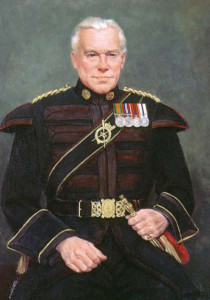
Peter, 12th Marquis of Lothian
The 12th Marquis of Lothian, Peter, was the son of Capt. Andrew Kerr and grandson of Admiral Lord Walter Kerr, who in turn was the youngest son of the 7th Marquis; he succeeded his cousin at the age of 19. Educated at Ampleforth and Christ Church, Oxford he served in the Scots Guards during the War and continued the family’s tradition of public service as a British delegate to the United Nations, Under-Secretary at the Ministry of Health, Under-Secretary at the Foreign Office, and from 1972 to 1974 was an MEP. He restored Monteviot to the design of a cousin Schomberg Scott in 1962, and subsequently restored Ferniehirst Castle, the pre-Union seat of the Kerrs, where he and his wife Antonella lived.
Their eldest son Michael, 13th Marquis of Lothian, PC, QC, MP, who with his wife, Lady Jane Fitzalan Howard (daughter of the 16th Duke of Norfolk) now lives at Monteviot. Also educated at Ampleforth and Christ Church, Oxford , he has also followed a political career as MP for Berwickshire and East Lothian (1974), Edinburgh South 1979 – 87, and now Devizes. He was under-Secretary at the Scottish Office, Minister of State for Northern Ireland, Chairman and later Deputy Leader of the Conservative Party, Deputy Leader of the Opposition and Shadow Foreign Secretary. He has two daughters, Lady Clare and Lady Mary Kerr.
